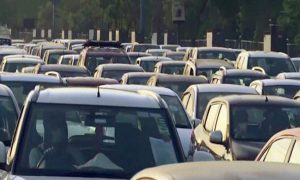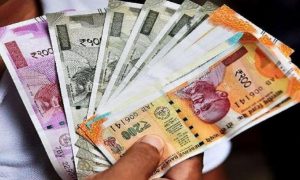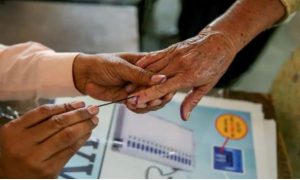The number of coronavirus disease (Covid-19) cases in India surpassed 200,000 on Tuesday, nearly doubling over 15 days, even as a considerable reopening of national transport and business activity fuelled fears of localised outbreaks emerging in new areas beyond urban hot spots that have so far pushed the contagion.
Globally, there are now 6.4 million infections of Sars-CoV-2, which causes Covid-19, and close to 380,000 deaths. In India, the number of fatalities on Tuesday was 5,753. The case fatality rate (CFR) in the country, however, stood at 2.8%, lower than the worldwide figure of 5.9%. About a fourth of India’s total infections have been reported over the past week.
“Our Covid-19 fatality rate of 2.82% is among the lowest in the world, compared to a global fatality rate of 6.13%. We have been able to achieve this due to timely identification of cases and proper clinical management,” Union health ministry joint secretary Lav Agarwal said at a news briefing on Tuesday.
Official data from states showed 100,289 patients have so far recuperated from the disease in the country, taking the recovery rate to 48.4%, which is among the most promising figures on the infection across the world. The low CFR and high recovery rate indicate that India may not be witnessing an impact as severe as in some of the other countries ravaged by the pathogen.
While experts say the peak of the outbreak is yet to come, an analysis on preprint server medRxiv showed that there could be independent regional crests across the vast geography of the country at different points in time. “The peaks might start as early as the end of July in some states and go all the way to September in many others,” said the research paper titled ‘Lockdown Effect on Covid-19 Spread in India’. Some studies also expect another infection spurt in winter this year.
The Indian Council of Medical Research (ICMR) said India was “far away from the peak”. “Our preventive measures to curtail Covid-19 have been very effective,” said ICMR scientist Nivedita Gupta.
In the 93 days since the outbreak began, total infections were at 207,112 and 5,753 people died of the disease till Tuesday. Three states – Maharashtra, Tamil Nadu and Delhi – currently account for half of all infections in the country but the Union government has identified 145 new districts, mostly rural, that have reported cases over the past three weeks and could emerge as “epicentres”. New infections have been reported among the millions of migrants returning to their home towns from urban centres amid a national lockdown that has slowed economic activity.
The latest 50,000 infections were recorded in a week. India reported its first 50,000 Covid-19 cases in nearly 66 days, with a wave of infections beginning in March after three isolated cases were first reported in Kerala in January. It took 12 days for the cases to climb from 50,000 to 100,000.
The disease’s doubling rate, which is defined as the average period it takes for a twofold rise, changed from 13.9 days on May 18 – the day the cases hit 100,000 – to 15.2 on Tuesday. The rate was four days at the beginning of April.
With a surge in Covid-19 cases, India has overtaken Germany and France to become the seventh biggest hot spot of the pathogen, which has rapidly swept the entire globe.
“It is wrong comparison to look at total number of Covid-19 cases only and mention that India has the seventh highest cases. Our population too should be considered… Fourteen countries with total similar population as India have reported 22.5 times more cases and 55.2 times deaths,” Agarwal said.
Experts say the cases are expected to surge as India exits the national lockdown – necessitated by the pandemic – in a graded manner and could spread to the rural parts of the country.
The Centre has also reoriented its strategy against the outbreak – from asking people to “stay home” to break the chain of infections, it is now asking citizens to learn to live with the virus by ensuring strict social distancing and hand hygiene.
“Our battle with Covid-19 is not over, but we will not be afraid of the virus. We will take all precautions and we are going to move on with our lives,” a tweet by the Press Information Bureau said while releasing a video on lockdown relaxations. “Our analysis shows that people at high risk from Covid-19 are elderly people and those with co-morbidities. One in every two Covid-19 deaths in India has been from the senior citizen population, who constitute 10% of our total population. 73% of Covid-19 deaths have been of people with co-morbidities such as diabetes, hypertension, heart and respiratory diseases,” Agarwal said.
The research paper published on medRxiv said that as isolated outbreaks spread across swathes of the country, the government needs to assess its response and preparedness. “Resources must be mobilised to help one cluster of states and then move to the next cluster. It might be useful for the central government and Indian Council of Medical Research (ICMR) to classify states in terms of the phases of the epidemic. Even as the worst-hit states are being addressed, the next set could be put on high alert. It is this dynamic policy intervention that will be required to deal effectively with the cascading pattern of the pandemic across Indian states,” it said.
Efforts to ramp up testing have also led to a wider detection of cases. About 120,000 samples are being tested for Covid-19 on average every day, with 476 government and 205 private facilities carrying out diagnoses. There are, however, concerns that India could still largely be testing people with symptoms targetedly, leaving scope for the disease to spread undetected.
On a question of whether community transmission, when a disease spreads indiscriminately in a population, was underway, the ICMR scientist said: “Instead of using the word community transmission, it is important to understand the extent of spread of the disease and where do we stand in comparison with other countries.” She added that ICMR was conducting a serological survey to assess the extent of the spread of the infectious disease. “Almost 34,000 people are being tested as a part of the survey; the results will be published in a week.”
A record single-day spike of 1,298 fresh cases took the Covid-19 tally in Delhi to 22,132 and the death toll mounted to 556. Maharashtra reported 2,287 new cases, taking the tally to 72,300, while fatalities rose to 2,465.
States with relatively fewer cases have seen spikes as residents, including migrant workers travelling in special trains, have returned home. UP reported 369 fresh Covid-19 cases, taking the tally to 8,729, including 2,404 patients who are migrant workers. Experts say the coming weeks will be crucial and the gains of the lockdown could get undermined if clusters are not contained effectively.





































